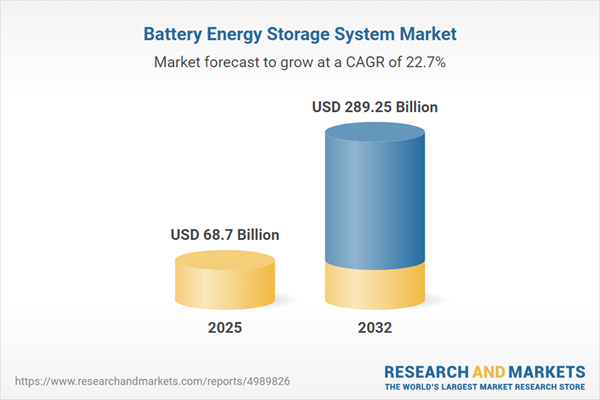Speak directly to the analyst to clarify any post sales queries you may have.
The battery energy storage system market is undergoing rapid transformation as utilities, developers, and technology providers prioritize flexible infrastructure to meet emerging energy challenges. Senior decision-makers require a structured analysis of evolving technologies, regulatory shifts, and competitive dynamics to stay ahead in a complex landscape.
Market Snapshot: Battery Energy Storage System Market Growth and Trends
The Battery Energy Storage System Market grew from USD 56.29 billion in 2024 to USD 68.70 billion in 2025. It is expected to continue growing at a CAGR of 22.70%, reaching USD 289.25 billion by 2032. This remarkable market trajectory reflects rising demand for grid stability, accelerated renewable adoption, and increasing regulatory support for electricity storage assets globally. Expansion is propelled by technology advances, multi-sector partnerships, and evolving policy frameworks shaping the competitive landscape.
Scope & Segmentation of the Battery Energy Storage System Market
This report examines critical aspects of the battery energy storage system market, profiling technology adoption, competitive strategies, regulatory dynamics, and regional differences. Comprehensive segmentation enables tailored insights into high-potential opportunities:
- Component: Battery cells, battery management systems (BMS), energy management systems (EMS), power conversion systems (PCS)
- Battery Type: Lead-acid, lithium-ion (including lithium iron phosphate and nickel manganese cobalt oxide), nickel-based, sodium-sulfur batteries
- Energy Capacity: 100–500 megawatt-hours, above 500 megawatt-hours, below 100 megawatt-hours
- Connection Type: Hybrid, off-grid, on-grid configurations
- Deployment: Behind-the-meter, front-of-the-meter
- Application: Commercial and industrial, residential, utility-scale use cases
- Regional Coverage: North America (United States, Canada, Mexico), Latin America (Brazil, Argentina, Chile, Colombia, Peru), Europe (United Kingdom, Germany, France, Russia, Italy, Spain, Netherlands, Sweden, Poland, Switzerland), Middle East (United Arab Emirates, Saudi Arabia, Qatar, Turkey, Israel), Africa (South Africa, Nigeria, Egypt, Kenya), Asia-Pacific (China, India, Japan, Australia, South Korea, Indonesia, Thailand, Malaysia, Singapore, Taiwan)
- Key Companies: ABB, AEG Power Solutions, The AES Corporation, Austin Energy, BYD Company, C&D Technologies, Central Electronics, CMS Energy, Delta Electronics, DTE Energy, Duke Energy, EnergyNest, Eversource Energy, GE Vernova, Georgia Power, Hitachi, HMS Industrial Networks, Honeywell, Johnson Controls, Ktech Energy, LG Chem, NextEra Energy, Nidec, Pacific Gas and Electric, Panasonic Holdings, Primus Power, RES Group, Samsung SDI, Saturn Power, Siemens, Sonnen, Stantec, Suzhou Surge Power, Tesla, Toshiba, TotalEnergies, Viridi Parente, Xcel Energy, SPP Development Ukraine
Key Takeaways for Battery Energy Storage Decision-Makers
- Innovations in cell chemistry and integration platforms are unlocking differentiated value across energy, commercial, and industrial segments.
- Decentralized architectures, including microgrids and virtual power plants, are enabling greater grid flexibility and supporting new service models.
- Regional supply chain strategies and regulatory incentives are prompting companies to localize manufacturing and adapt to evolving policy requirements.
- Partnerships between utilities, technology vendors, and developers are increasingly vital for delivering turnkey solutions and managing system complexity.
- Integration of artificial intelligence in energy management systems supports predictive maintenance, real-time optimization, and adaptive energy dispatch.
Tariff Impact on Manufacturing and Supply Chain Strategy
Recent United States tariffs imposed in 2025 have led global battery storage manufacturers to reassess sourcing strategies and regional production footprints. Companies are increasingly pursuing local gigafactory development and vertical integration to reduce exposure to international cost fluctuations and trade barriers. Adaptation to these policy changes offers both cost containment and enhanced supply chain resilience.
Methodology & Data Sources
This report is developed using a rigorous mixed-methods approach, including interviews with more than fifty industry experts, in-depth secondary research from market publications and filings, and expert workshops for validation. Data triangulation and ongoing peer review strengthen the reliability and actionability of findings.
Why This Report Matters to Industry Leaders
- Enables clear strategy development by mapping emerging technology, regulatory change, and competitive moves in the battery energy storage sector.
- Supports investment prioritization through segmentation insights and analysis of key market drivers and risks.
- Assists in benchmarking supply chain strategies and regulatory response, allowing organizations to adapt operations and partnerships for long-term resilience.
Conclusion & Forward-Looking Perspectives
This analysis equips decision-makers with actionable intelligence to accelerate growth, strengthen operational resilience, and capture opportunities across the energy storage ecosystem. By aligning resources to dynamic market signals, leaders can navigate ongoing industry transformation with confidence.
Additional Product Information:
- Purchase of this report includes 1 year online access with quarterly updates.
- This report can be updated on request. Please contact our Customer Experience team using the Ask a Question widget on our website.
Table of Contents
3. Executive Summary
4. Market Overview
7. Cumulative Impact of Artificial Intelligence 2025
Companies Mentioned
The companies profiled in this Battery Energy Storage System market report include:- ABB Ltd.
- AEG Power Solutions B.V.
- The AES Corporation
- Austin Energy
- BYD Company Limited
- C&D Technologies, Inc.
- Central Electronics Limited
- CMS Energy Corporation
- Delta Electronics, Inc.
- DTE Energy Company
- Duke Energy Corporation
- EnergyNest AS
- Eversource Energy
- GE Vernova
- Georgia Power Company
- Hitachi, Ltd.
- HMS Industrial Networks AB
- Honeywell International Inc.
- Johnson Controls International PLC
- Ktech Energy Co., Ltd.
- LG Chem, Ltd.
- NextEra Energy, Inc.
- Nidec Corporation
- Pacific Gas and Electric Company
- Panasonic Holdings Corporation
- Primus Power Solutions
- RES Group
- Samsung SDI Co., Ltd.
- Saturn Power Inc.
- Siemens AG
- Sonnen GmbH
- Stantec Inc.
- Suzhou Surge Power Technology Co., Ltd.
- Tesla, Inc.
- Toshiba Corporation
- TotalEnergies SE
- Viridi Parente, Inc.
- Xcel Energy Inc.
- SPP Development Ukraine
Table Information
| Report Attribute | Details |
|---|---|
| No. of Pages | 190 |
| Published | November 2025 |
| Forecast Period | 2025 - 2032 |
| Estimated Market Value ( USD | $ 68.7 Billion |
| Forecasted Market Value ( USD | $ 289.25 Billion |
| Compound Annual Growth Rate | 22.7% |
| Regions Covered | Global |
| No. of Companies Mentioned | 40 |









